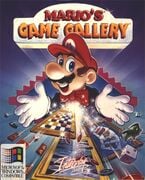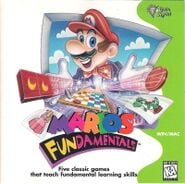Mario's FUNdamentals
- "Mario's Game Gallery" redirects here. For the playing cards, see Mario's Game Gallery (playing cards).
| Mario's Game Gallery Mario's FUNdamentals | |||
|---|---|---|---|
 Mario's Game Gallery box  Mario's FUNdamentals box | |||
| Developer | Presage Software, Inc. | ||
| Publishers | Interplay Entertainment Corp. Mindscape (PC version of Mario's FUNdamentals) | ||
| Platforms | MS-DOS (Mario's Game Gallery); Windows, Macintosh (Mario's FUNdamentals) | ||
| Release dates | Mario's Game Gallery: Mario's FUNdamentals: | ||
| Genre | Educational | ||
| Rating |
| ||
| Modes | Single player, multiplayer (up to two players) | ||
| Format | Home computer system:
| ||
| Input | Home computer system:
| ||
Mario's FUNdamentals (alternatively formatted as Mario's Fundamentals),[1] originally released as Mario's Game Gallery, is a compilation game in the Super Mario franchise, published by Interplay Entertainment and developed by Presage Software, Inc. for PCs running Microsoft Windows. Exclusive to the United States, it was originally released in 1995, and it was later reissued and retitled in 1998, with Mindscape publishing this re-release; a version for Macintosh computers was published by Stepping Stone.
Gameplay[edit]
Five traditional games are included: Checkers, Go Fish, Dominoes, Backgammon, and Yacht (an early version of Yahtzee). Gameplay for all the games is similar to their real-world counterparts, though pieces are altered to be themed after the Super Mario universe.
Checkers[edit]
Checkers is played on an 8-by-8 board with alternating red and black squares. Game pieces only occupy the black squares. The player can choose to play as Yoshis or Koopas. Each player starts with 12 pieces on the closest 3 rows of the board. Players take turns moving a piece each. Pieces can only move diagonally forward to empty squares. If there is an enemy piece in the way but the square beyond it is empty, the enemy piece can be captured by jumping over it. Koopas turn Yoshis into bubbles and pop them, while Yoshis swallow the Koopas. A player must take the opportunity to jump if such move is available, continuing to jump as long as there are enemy pieces to capture. A piece that reaches the furthest row on the board becomes a king (Big Yoshi or Bowser wearing a crown). Kings can move and capture backwards in addition to forwards. The game is over when the current player is unable to move, either due to having no pieces or all of them being blocked.
Go Fish[edit]
The goal is to try to make as many Books (sets of four matching cards) as possible.
Each player starts with 7 cards. During a player's turn, they may ask for a card they already have from the other player. If the other player has any cards of the chosen type, they must hand over all of them. Otherwise they are told to "Go Fish", or draw a card. Fishing is compulsory if the current player has no cards. A player can continue to ask for cards as long as they pick one the other player has or get the card they asked for after fishing. Once a player has all 4 cards of a same type, they lay down the "Book" and score for it.
The game is played with a deck of cards with no suits, each of the 13 types have four copies each. The following characters are represented:
- Goombas
- Koopas
- Rip Van Fish
- Little Toadies
- Bob-ombs
- Rexes
- Piranha Plants
- Big Boos
- Yoshis
- Marios
- Luigis
- Princesses
- Bowsers (misspelled as "Bowzers")
The draw pile is represented as a pool of water, from which a dolphin jumps out when the player fishes from it.
Dominoes[edit]
This game is played with a set of 28 bones or dominoes. Each player gets 7 dominoes at the start, the remaining 14 go into the boneyard. The player who has the highest double goes first and must play that domino. After that players take turns adding a domino to either end of the domino chain such that at least one end of the placed domino matches the value at end of the chain. If a player does not have any matching dominoes, they must draw from the boneyard or pass if there are no dominoes left. It is also possible to draw any number of dominoes before placing one down. The winner is the first player to end up with no dominoes at the end of their turn. If both players are unable to make a move when both still have dominoes left, the winner is the player whose dominoes in hand have the lowest sum of values.
The dominoes show all 28 possible combinations of the following values and the corresponding pictures:
- 0: Blank
- 1: Super Star
- 2: 3-Up Moon
- 3: Coin
- 4: Fire Flower (Super Mario World design)
- 5: Super Mushroom
- 6: Cape Feather
Backgammon[edit]
Backgammon is played on a board with 24 triangular points and fifteen pieces for each player on a set placement. The goal is to follow a flipped C-shaped path, with Mario going from bottom to top and the human player top to bottom. One player plays as the Yoshis and the other as the Koopas. When not moving, the Yoshis hide in their eggs and the Koopas hide in their shells. The player to go first is determined by rolling a single die, then starts their turn by rolling two dice. Each die can be used to move a single piece by the number of points shown on the die. The same piece may be moved multiple times in the same turn. A roll with same value on each dice allows for four moves with said value. Only one player's pieces can be on a particular point. A piece cannot be moved if it would land on a point occupied by two or more of the opponent's pieces. Moving to a point occupied by a single opponent piece will cause that piece to go to the bar in the middle of the board. The owner must first bring those back before being allowed to make other moves. Bringing a piece back requires a dice roll that allows a legal move from "point 0" (e.g. a roll of 3 allows a piece to re-enter on the 3-point as long as there are less than 2 opposing pieces there). Once all of a player's pieces arrive in the final 6 points, they can be taken off the board by a die roll needed to move them to "point 25" (e.g. a roll of 4 allows taking a piece off from 21-point). A die roll can also be used to take off the piece furthest from the goal if the highest die roll is higher than the distance of that piece from the goal. A player that cannot make any legal moves ends their turn. The first player to take all of their pieces off the board is the winner.
There are no bets and doubling cube used in this game.
Yacht[edit]
The goal is to fill in an initially empty scoresheet using rolls of five dice. A player may roll the dice up to 3 times per turn and choose to hold some of the dice between rolls. The player must choose a line on the scoresheet, gaining points depending on which line is chosen and the value of the dice. Each line can only be chosen once per game. The player with the most points on the completed scoresheet is the winner.
The lines on the scoresheet are as follows:
- Yacht: 50 points if all the dice show the same value, otherwise 0 points.
- Big Straight: 30 points if all the dice show a sequence (1-2-3-4-5 or 2-3-4-5-6), otherwise 0 points.
- Sm. Straight: 25 points at least 4 dice show a sequence (1-2-3-4, 2-3-4-5, or 3-4-5-6), otherwise 0 points.
- 4 of a Kind: The sum of all dice if there are 4 with the same value, otherwise 0 points.
- Full House: The sum of all dice if there are 3 with the same value and 2 with a different but identical value, otherwise 0 points.
- Choice: The sum of all dice regardless of value.
- Sixes: The sum of the dice showing 6.
- Fives: The sum of the dice showing 5.
- Fours: The sum of the dice showing 4.
- Threes: The sum of the dice showing 3.
- Deuces: The sum of the dice showing 2.
- Aces: The sum of the dice showing 1.
Critical reception[edit]
Both versions of the game have received mixed reception. Upon its initial release, various publications found it to be a good educational game; The State and The Miami Herald praised it for "providing fun for the whole family", and the Los Angeles Times said that it would appeal to younger gamers. Much later, the game was negatively received by authors David Wesley and Gloria Barczak, who labeled it and the other Super Mario games manufactured by third-party publishers in the 1990s, which were made without the supervision of Nintendo, as "a flood of ill-conceived Mario spin-offs" that almost destroyed the Super Mario brand.[2]
Gallery[edit]
MS-DOS[edit]
Windows[edit]
Multimedia[edit]
| It has been requested that more audio and/or video files related to this article be uploaded. Specifics: Windows Please upload music, sound effects, voice clips, or any videos for this article. See the help page for help getting started. |
Staff[edit]
- Main article: List of Mario's FUNdamentals staff
Quotes[edit]
- Come here, fishy-fishy! Here, fishy-fishy!
- Knock knock. Who's there? Jamaica. Jamaica who? Jamaica me cuckoo crazy!
- Knock knock. Who's there? Giovanni. Giovanni who? Giovanni hurry up and play for cryin' out loud!?
Pre-release and unused content[edit]
See also[edit]
Notes[edit]
- A Super Nintendo Entertainment System port of the game (under the Mario's Game Gallery name) is rumored to have been in development before being canceled.[citation needed]
- Mario refers to Toad by a pet name, "Little Toadie". This nickname originates from the 1993 Nintendo Character Guide, a set of guidelines and information given by Nintendo of America to licensing partners.
References[edit]
- ^ File:Mario's FUNdamentals Windows.png
- ^ Wesley, David; Barczak, Gloria (2010). Innovation and Marketing in the Video Game Industry: Avoiding the Performance Trap. Gower Publishing Ltd (English). ISBN 978-0-566-09167-4.





















